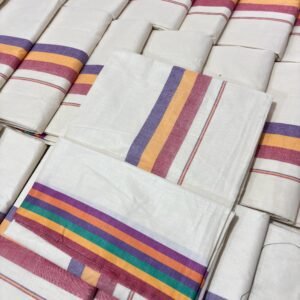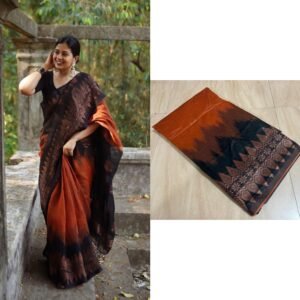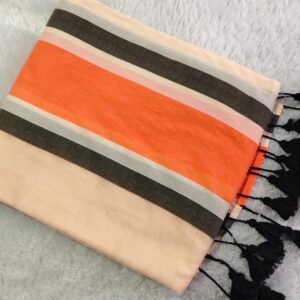The Thanjavoor Pattu Saree, hailing from the culturally rich region of Thanjavur in Tamil Nadu, is a testament to the exquisite artistry and weaving traditions of South India. While often associated with the grandeur of Kanjeevaram silk sarees due to geographical proximity and similar weaving techniques, Thanjavoor Pattu Sarees possess their own distinct charm and heritage.
Here’s a description of what makes a Thanjavoor Pattu Saree special:
Material and Weaving:
- Silk Predominance: Typically woven from pure mulberry silk, these sarees are known for their lustrous texture and fine quality. The silk threads contribute to a rich and elegant drape.
- Zari Work: Like many South Indian silk sarees, Thanjavoor Pattu Sarees often feature intricate zari work, using threads made of gold or silver. This zari can adorn the borders, pallu (the decorative end piece), and sometimes even the body of the saree, adding to its opulence.
- Handloom Legacy: These sarees are primarily handwoven by skilled artisans, carrying forward generations of weaving expertise. The handloom process allows for intricate designs and a unique touch in each saree.
- Korvai Technique: Historically, the Korvai technique, where the body and border of the saree are woven separately and then interlocked, was prevalent in the Thanjavur region, much like in Kanchipuram. This results in contrasting borders with a distinct and strong join.
Design and Motifs:
- Temple Inspirations: Given Thanjavur’s rich architectural heritage, with magnificent temples like the Brihadeeswarar Temple, the designs often draw inspiration from these structures. Motifs of temple towers (gopurams), geometric patterns found in temple architecture, and other religious symbols may be woven into the saree.
- Natural Elements: Motifs inspired by nature, such as peacocks, elephants, floral creepers, and stylized leaves, are also common, symbolizing auspiciousness and beauty.
- Figurative Representations: Sometimes, depictions of deities, mythical creatures, or scenes from epics can be found, adding a narrative element to the saree.
- Color Palette: Thanjavoor Pattu Sarees often feature vibrant and contrasting colors. Traditional combinations like red with gold, green with maroon, and blue with yellow are popular, exuding a sense of traditional grandeur.
Distinguishing Features (though sometimes overlapping with Kanjeevaram):
- Regional Nuances: While sharing similarities with Kanjeevaram sarees, Thanjavoor Pattu Sarees might exhibit subtle differences in motifs, color combinations favored in the region, and the fineness of the silk or zari used.
- Historical Significance: Thanjavoor has a long history of silk weaving, with royal patronage in the past contributing to the development of unique styles. Historically, some Thanjavur sarees even incorporated Ikat weaving techniques, though this is less common now.
- Thirubuvanam Connection: The nearby town of Thirubuvanam in the Thanjavur district is also renowned for its silk sarees, often considered under the broader umbrella of “Thanjavoor Pattu.” These sarees are known for their intricate border and pallu designs with extensive zari work and a higher thread count.
Occasion and Significance:
- Thanjavoor Pattu Sarees, with their rich silk and intricate designs, are highly valued for special occasions like weddings, festivals, and important family gatherings. They are considered a symbol of elegance, tradition, and prosperity.
In essence, the Thanjavoor Pattu Saree is more than just a garment; it’s a piece of the region’s cultural fabric, reflecting its artistic heritage, architectural grandeur, and deep-rooted traditions of silk weaving. While it shares a kinship with the famed Kanjeevaram saree, it holds its own unique identity and continues to be cherished for its beauty and craftsmanship.
.












 6 colour border mulloth saree (Nyla Usha inspired)
6 colour border mulloth saree (Nyla Usha inspired)  Big border black colour cotton saree
Big border black colour cotton saree  double side temple korvai cotton saree.
double side temple korvai cotton saree.  Red border Black mul mul saree
Red border Black mul mul saree  Black and Orange mul mul saree
Black and Orange mul mul saree  Checks mul cotton aiswarya lekshmi inspired
Checks mul cotton aiswarya lekshmi inspired